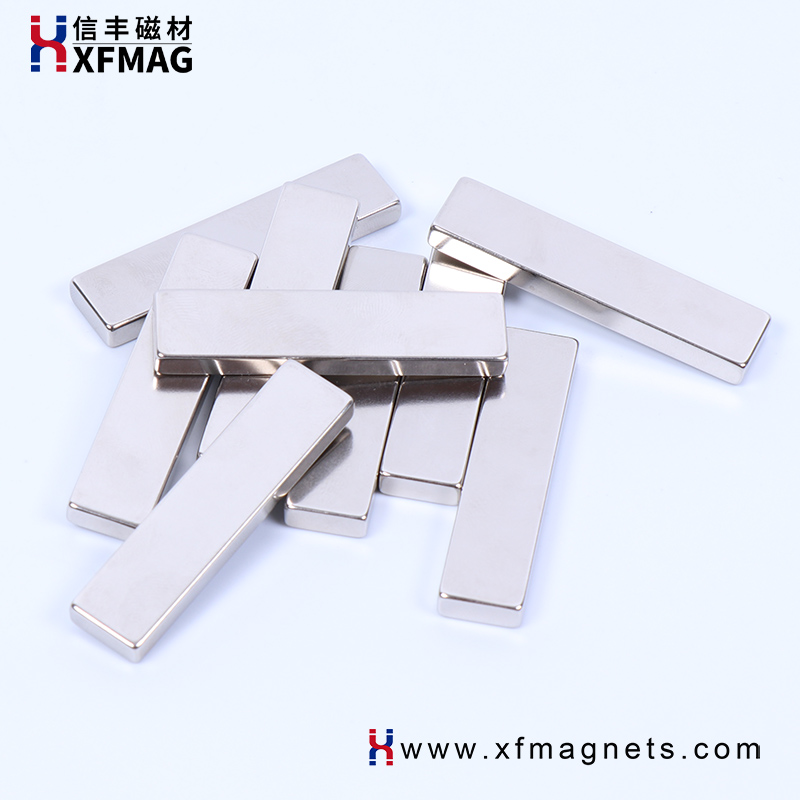NdFeB magnets are very magnetic. You should avoid holding your hands or other parts of your body with magnets in the first place. The main raw materials for the production of Ndfeb Neodymium Magnet are metal neodymium, metal praseodymium, pure iron, aluminum, boron-iron alloy and other raw materials.
The production process of NdFeB magnets, in layman’s terms, is as follows: the materials are mixed and smelted, and then the smelted metal blocks are broken into small particles. Put the small particles into the mold and press them into shape. Then sintered. What is sintered is the blank. The shape is generally square, or Neodymium Cylinder Magnets.
Taking the Neodymium Block Magnets as an example, the size is generally concentrated in the length and width of 2 inches, and the thickness is about 1-1.5 inches. The thickness is the magnetization direction (magnets are all oriented, so there is a magnetization direction). Then, according to the actual needs, the blank is cut into the required size and shape. The cut magnets, chamfered, cleaned, electroplated, magnetized, and that’s it.
Utilize various shapes of NdFeB magnets, such as round, special-shaped, square, tile-shaped, trapezoidal. Different size materials are processed using different machine tools to cut rough materials, and the machine operator determines the accuracy of the product.
The coating quality of the surface coating, zinc, nickel, nickel copper nickel electroplating copper and gold and other electroplating processes. Plating options can be done on the product according to customer requirements.
A brief summary of the pros and cons of High-Quality Electroplating Permanent Magnet is to grasp the performance, dimensional tolerance control, and judge the appearance inspection and evaluation of the coating. Detecting the Gaussian surface of the magnetic flux of the magnet, etc.; dimensional tolerance, the accuracy that can be measured with a vernier caliper; coating, the color and brightness of the coating and the bonding force of the coating, and the surface of the magnet can be observed by appearance. Drop edges and corners to evaluate the quality of the product.
AlNiCo magnet: It is an alloy composed of aluminum, nickel, cobalt, iron and other trace metal elements. The casting process can be processed into different sizes and shapes, and the machinability is very good. Cast Alnico Magnet has a low reversible temperature coefficient, and the operating temperature can be as high as 600 degrees Celsius.
AlNiCo permanent magnet products are widely used in various instrumentation and other application fields.
Permanent magnets can be natural products, also known as natural magnets, or artificially manufactured (magnets are NdFeB magnets).
Non-permanent magnets: Non-permanent magnets will suddenly lose their magnetism when heated to a certain temperature, which is caused by the arrangement of the many “meta-magnets” that make up the magnets from order to disorder; the magnets that have lost their magnetism are placed in a magnetic field. , when the magnetization reaches a certain value, it is magnetized again, and the arrangement of the “element magnets” changes from disorder to order.
Ferromagnetism refers to the magnetic state of a material with spontaneous magnetization.
After some materials are magnetized under the action of an external magnetic field, even if the external magnetic field disappears, they can still maintain their magnetized state and have magnetism, that is, the so-called spontaneous magnetization phenomenon. All Rare Earth Permanent Magnet are ferromagnetic or ferrimagnetic.
When talking about the magnetic source, electromagnetic induction, and magnetic devices of Permanent Magnet Materials, we have already mentioned the practical application of some magnetic material electromagnets. In fact, magnetic materials have been widely used in various aspects of traditional industries.
Post time: Sep-24-2022


